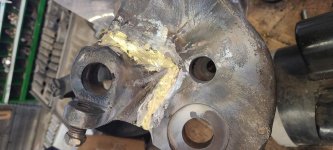Rockmonton
Plastic
- Joined
- Dec 2, 2020
Dropped a cast iron piece a while back.
Made my first attempt ever at brazing
Heated for about 20 min with a tiger torch, then oxyacetylene to braze.
Doesn't look pretty, and there's some spots I definitely need to go back and try again.
I'm looking for some tips on getting it better. Should I melt apart and try again in total?



Made my first attempt ever at brazing
Heated for about 20 min with a tiger torch, then oxyacetylene to braze.
Doesn't look pretty, and there's some spots I definitely need to go back and try again.
I'm looking for some tips on getting it better. Should I melt apart and try again in total?






